My 78 year-old father recently called me saying that his computer had stopped working. He lives on Vancouver Island and I’m on the mainland, so I’m not able to assist him in person. So he called the geek squad and they came over and told him his hard drive was dead and that it would be $250 for them to replace it.
Well, his computer is well past it’s prime and I’m not even sure they make IDE hard drives anymore. So I suggested that he buy a new computer instead. He agreed and gave me a budget of $700 to work with.
His #1 complaint regarding his old computer was “Why is computer so slow”? He even called Shaw and complained that his computer was too slow. Shaw immediately took that opportunity to sell him the “X-treme” high-speed Internet package.
So the new computer had to be responsive at all times, even during virus scans. To get that kind of responsiveness, an SSD drive is a must. Since I could not find any budget PCs with an SSD drive, I decided to build one.
The components I chose were as follows:
| Processor |
Intel Core i3 530 |
$117.99 |
| Memory |
OCS OCZ3G1333LV4GK 4GB 2x2GB |
$93.99 |
| Storage |
Intel X25-V 40GB SSD |
$112.99 |
| Motherboard |
Asus P7H55-M Pro |
$99.99 |
| DVD |
Sony Optiarc 24X DVDRW |
$19.99 |
| Case |
Apex DM-387 mATX HTPC case |
$45.99 |
| O/S |
Windows 7 home premium |
$99.99 |
| Sub Total |
|
$590.93 |
| Taxes plus shipping |
|
$80.75 |
| Grand Total |
|
$671.68 |
Graphics was not a consideration since he will not be doing any 3D gaming. The built-in GPU graphics of the Core i3 530 should be good enough for Windows Aero.
My first choice in motherboards was the Gigabyte H55M-D2H. Unfortunately, it was not in stock (at NCIX.com) in Vancouver, and I needed this shipped next day so I could build and deliver it on the weekend. Luckily, the Asus board worked out just fine.
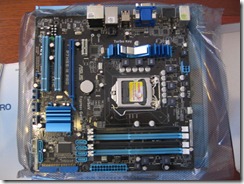
The Intel Core i3 530 is an excellent budget processor, ranking as one of recommended processors in Tom’s Hardware Best Gaming CPUs For The Money: August 2010. Sure, AMD makes good budget processors but the Intel's seem to have much more overclocking headroom, which means they are running well below their thermal capacity. My last experience with an AMD processor was the 9850 black edition which I actually had to underclock to get stable operation! And that’s with a decent aftermarket cooler!
One interesting aspect of the new Intel Core processors is that there are no more pins. You just drop it in it’s socket and a clamp holds it down. Neat.
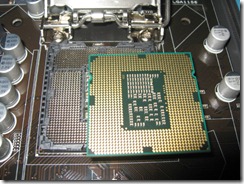
The memory was largely bought on price (with a $15 mail-in rebate). Though after reading some of the reviews, it looks like this memory requires 1.65V for stable operation at its rated speed. Ugh. Sure is pretty though.
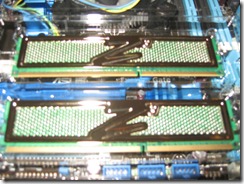
The Intel X25-V 40GB SSD drive is anemic in size for most people. However, my father only uses his computer for Internet and Word documents, so this will be plenty of space for him. Performance in random reads are excellent, which is what causes most stalling behavior in PCs. This SSD also came out-of-the-box with the latest firmware.
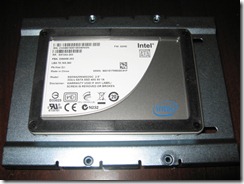
The Apex case is a half-width micro-ATX case which includes a mini 275 watt power supply. Usually I don’t like to use bundled power supplies, since the quality is usually crap, but this one is also sold individually, and had decent reviews. Since this will be a low power computer (no GPU or traditional hard drive), 275 watts should be plenty.
Putting all the components together was fairly straight forward. The Apex case had a nice swing-out bay for installing the DVD and SSD drives. There are only 2 SATA power connectors, and they are on the same cable, so the DVD and SSD had to be mounted side-by-side. If you need more than 2 SATA power connectors, you will need an additional adapter.
Here’s a look at the final build.
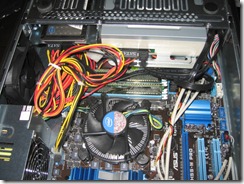
After installing Windows 7 Home Premium, I ran the WEI benchmark (Windows Experience Index). As expected, the lowest score came from the built-in GPU of the Core i3 530 with a score of 4.8 for Desktop Aero performance. Despite this low score, the Aero desktop was smooth and responsive. The CPU score was an impressive 6.9, which matches the score of my 2 1/2 yr old E8400 processor overclocked to 3.6 GHz. The SSD drive scored an awesome 7.3.
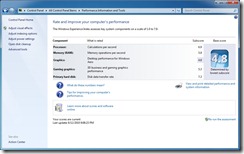
Let’s see what a little overclocking bump will do. I increased the FSB speed to 167 from 133. This FSB speed allows the memory to stay at its rated 1333 speed. This upped the core CPU speed from 2.93 GHz to 3.68 GHz on the stock cooler.
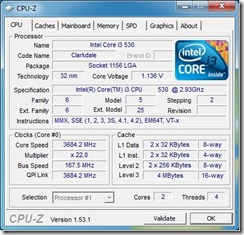
Rerunning the WEI benchmark upped the CPU score to a new class of processor (7.1) and the SSD got a little bump to 7.4.
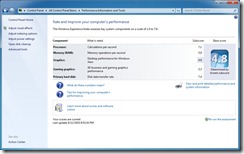
With a good aftermarket cooling solution, there is obviously a lot of room for overclocking. However, I don’t have the time to do a thorough stability test, so back to stock speed it goes. My father would likely not notice a difference anyway. Reliability is the key ingredient for this build.
After installing all the necessary Office and anti-virus software, I ran a test by starting a virus scan while doing other operations like surfing the web. There was no noticeable slowdown whatsoever with system responsiveness. Awesome.
I also set the default shutdown button to sleep. The wake from sleep was virtually instant. His last computer took at least 10 minutes to fully boot and become responsive. Google earth was also smooth and responsive, despite its 3D requirements.
After delivering the computer to my father, he was very impressed. The only downside we discovered was with the Help and Support feature of Windows 7 verses Windows XP. Windows 7 now requires you to recite a 12 digit code to get remote assistance support. Getting my 78 year old father to recite a 12 digit code is virtually impossible. ARRRGG!!! Luckily, my company has a Goto Assist subscription which I can use for the occasional support call.
Overall, with its instant-on capability and virtually instant application launching, this build achieves its goal of being a super-repsonsive, reliable basic computer for web browsing and office applications. Its sleek low-profile case and HDMI output capability could make this an ultimate home theater PC with the addition of a tv tuner card and some additional storage, or a windows home server.